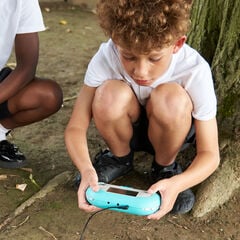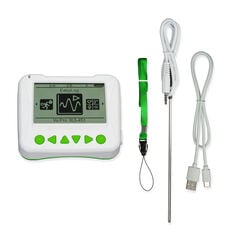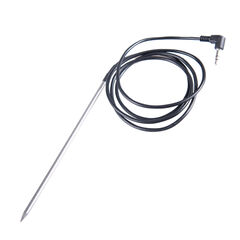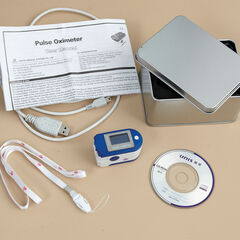Getting the most out of your Data Logger
In this blog we explore data logging and suggest possible ways it can be integrated into the curriculum. We show you the resources we can offer for data logging and demonstrate how to use the products so that you can get the best out of your data logging experience.
So, let’s get started!
What is a data logger and why is it important?
A data logger is a useful piece of equipment that captures data over a given period of time. Typically, data loggers contain built-in sensors such as for temperature, light and sound. These sensors can be programmed to capture different amounts of external information for varying amounts of time.
A data logger is great for…
- Capturing data and information for a purpose. As part of their scientific experiments, pupils can use a data logger to collect the necessary information that will allow them to explore and test their hypotheses. They can create tables and graphs to present the data in a useful way.
- Accuracy, precision and speed. Data loggers can capture and store hundreds of measurements every minute, providing a wide range of data that children can then investigate, explain and analyse. As they analyse this data, children will not only be developing their scientific skills but also their literacy, numeracy and higher order thinking skills.
- Bringing science lessons to life. Collect and store data either in real time or after recording. See real-life examples of technology, computing and science working together.
A data logger is great for all ages from Primary right through to Secondary.
TTS Data Logging Products
At TTS we collaborate with teachers, practitioners and educational experts to develop innovative resources that can help to enhance learning.
Here are some of the data logging resources we have to offer:
Log-Box Data Logger
Our new Log Box measures temperature, light, sound, and pulse! Perfect for all scientific investigations.
Designed specifically to appeal to children,this handy Log Box will flash different colours to show when the App is being used. The software allows children to choose how data is displayed in graph, bar chart or table formats.
Click here to watch the video clip for an introduction to the new log-box
Advantages of the Data Logger
- Use remotely.
- Ideal for taking with you on school outings and on residentials.
- Introduces children to live data.
- Potential for three different temperature probes.
- Adjustable units of measurement.
Want to discover how to use the TTS Log Box? If so, see the clip below to find out more from Dan Bunker from United Learning.
Also use these child-friendly cards to introduce the TTS Log-Box to your class. Click here.
Bluetooth Data Logger
The Bluetooth Data Logger has multiple sensors, including light, sound, infra-red and temperature. It is compatible with tablet use. View live readings, or download data to be viewed later.
Click here to watch Dan Bunker from United Learning explain how to use the Bluetooth Data Logger
VU+ Primary Data Logger
- Three built-in sensors for light, temperature and sound.
- Records data remotely into its memory.
- Connect to a computer using Bluetooth or USB.
Rugged Robot Data Logging Backpack
Collect data on light, sound and temperature on outdoor adventures by attaching Rugged Robot’s Data Logging Backpack. This easy-to-use data logger is a fun way to track live data and to combine learning around coding and computational thinking. Use with Rugged Robot or alternatively, on its own.
To find out more about how to use the Data Logging Backpack with Rugged Robot, click here.
How can I use data logging across the Curriculum?
Data loggers are a great way of combining Science, Technology, Engineering and Maths (STEM) into a real-world investigation topic that will develop pupils’ problem-solving skills. For instance, pupils can learn about climate change and looking after plants through using data logging equipment.
Ways to use your Data Logger:
Maths- Hands-on data handling activities measuring temperature, light and sound.
Computing- Using technology to collect and analyse data and work with variables.
PE- Measuring temperature and heart rates before, during and after exercise.
Geography- Learning about weather and its effects such as finding hot and cold places and developing fieldwork e.g. comparing noise levels of different areas around school.
And of course, Science! Here are some ways that data logging fits into the science curriculum and some suggestions for activities that use a data logger.
Data Logging in the National Curriculum
KS1 Programme of study
“Pupils should seek answers to questions through collecting, analysing and presenting data.”
Skills
- observing closely, using simple equipment.
- using their observations and ideas to suggest answers to questions.
- gathering and recording data to help in answering questions.

Lower KS2 Programme of study
“They should learn how to use new equipment, such as data loggers, appropriately. They should collect data from their own observations and measurements, using notes, simple tables, and standard units, and help to make decisions about how to record and analyse this data. With help, pupils should look for changes, patterns, similarities, and differences in their data to draw simple conclusions and answer questions. With support, they should identify new questions arising from the data, making predictions for new values within or beyond the data they have collected and finding ways of improving what they have already done.”
Skills
- making systematic and careful observations and, where appropriate, taking accurate measurements using standard units, using a range of equipment, including thermometers and data loggers.
- setting up simple practical inquiries, comparative, and fair tests.

Upper KS2 Programme of study
“They should make their own decisions about what observations to make, what measurements to use and how long to make them for, and whether to repeat them; choose the most appropriate equipment to make measurements and explain how to use it accurately. Decide how to record data from a choice of familiar approaches; look for different causal relationships in their data and identify evidence that refutes or supports their ideas. Use the results to identify when further tests and observations might be needed; recognise which secondary sources will be most useful to research their ideas and begin to separate opinion from fact.”
Skills
- taking measurements, using a range of scientific equipment, with increasing accuracy and precision, taking repeat readings when appropriate and recording data and results of increasing complexity.

For more ideas click here for activity suggestions and here to see an example data logging lesson.
Data Logging in action
Curious to see how data logging is being used in classrooms? Explore our case studies and testimonials from schools and educational settings just like yours. These stories highlight the different ways teachers and practitioners have used Data Logging in their teaching, showing the impact it’s had on children’s engagement and learning outcomes. Click here to read Case Study.
If you have any great ideas for data logging, please share your experiences with us. We’d love to hear from you.
Other resources for logging data?
Other resources you might like to explore are:
- TTS Logging time rechargeable stop watches SC00945
- Log-Box Temperature Probe SC10205
- Mini Light Meter SC10052
- Windowpane Thermometer SWTHLG
- Weatherproof Digital Thermometer SC10328
- Easi-Pulse Oximeter Pulse meter SC00642
- TTS Time Lapse & Motion Activated Camera SC00946
- TTS Detecting Sound & Heat Sonic Sensors SC00957
- Decimetre Handheld Sound Meter SDEC2
For more information and ideas read our other blogs:
Data Loggers Introducing Data Logging Maria Temel Bolton ICT EdTech expert 2021 //www.tts-group.co.uk/blog/2021/08/27/data-loggers.html#q=data%2Blogging&searchType=simple-search&start=1
Re-Introducing the Data Logger Rugged Maria Temel 2023
With many thanks to Dan Bunker from United Learning and the staff and pupils at The Valley Community Primary School, Bolton.






























